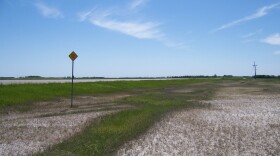Last week’s Natural North Dakota centered on the call of sandhill cranes, one of the more interesting sounds of fall in North Dakota. Other calls of fall would include the cackling of snow geese high overhead, the honking of Canada geese, and the booming-hooting of tundra swans.
An important sound of fall
It might sound strange, but the sounds of plants are also an important sound of fall. I was reminded of that recently when I overheard a conversation in which a woman was hoping to buy a home in a particular area, and an important aspect of the site was that it had to include a cottonwood tree so she could hear the rustling of the leaves.
When it comes to the sounds of plants, wind through the conifers and the quaking of aspen leaves are often mentioned. But I suspect that for many North Dakotans, the rustling of cottonwood leaves are even more iconic and may evoke some vivid memories.
What makes cottonwood leaves stand out?
What is it about aspen and cottonwood leaves that they speak to us more than others?
The leaf stalks of most tree leaves are round and rather rigid. Aspen leaf stalks, however, are very flattened in cross section and quite flimsy. As a result, the slightest breeze causes the leaves to get blown around and bump into each other producing the “trembling” or “quaking” sound. It is similar with cottonwood leaves. They are a little larger and wider than aspen leaves. And although the leaf stalks are not as flattened as those of aspen, they are flattened a bit, and rather flimsy.
Winter is waiting in the wings, so listen carefully and be alert to all those sounds of fall, including the tree leaves. And while you are at it, give some thought as to what memories you have of being amongst the rustling of cottonwood leaves. What do the cottonwood leaves say to you?
—
Reminder: Orionids Meteor Shower next week
The peak viewing period for the Orionids Meteor Shower is coming up on the night of October 21 and early morning hours of October 22. Estimates are that there will be around twenty meteors per hour during the peak viewing period.
The Orionids will run until November 7 and overlay with the Taurids Meteor Shower which will run to December 10. Make a point to check them out!





